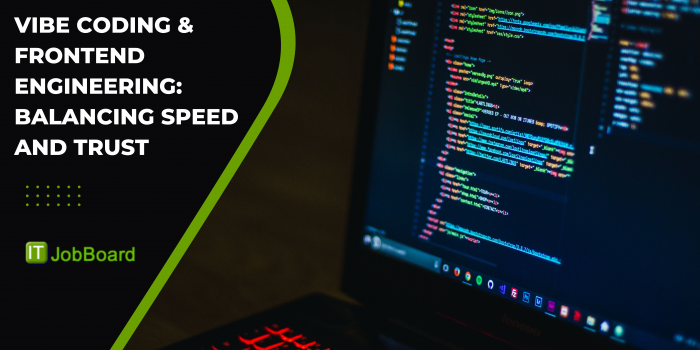Vibe Coding & Frontend Engineering - How AI Speeds Development Without Losing Trust

What Is Vibe Coding and Why Do Developers Love It?
The term “vibe coding” may sound fantastical, but simply put, you vibe, and the code emerges. For solo builders, vibe coding can feel unreal—with AI producing scaffolding, components, and repetitive boilerplate, you can actually concentrate on the pace and time to ship working features. As the demand for IT jobs continues to grow worldwide, many developers are looking to AI as a way to accelerate their workflows without losing focus on creativity.
The Wonderful World of Scaffolding and Automation
Vibe coding works best for rinse-and-repeat tasks: set ups of tests, multi-line boilerplate API, content generation, wiring up an integration, etc. Rather than slogging through painful lines of code, you simply vibe, let AI do some scaffolding, and potentially move much faster.
Where Vibe Codes Falls Flat (and Why It Can Be Dangerous)
That said, dreamy coding is limited in its scope. When compliance, security, or any kind of long-term stability affects your output — “vibing” the code to completion is insufficient. Think about it: you wouldn’t want PCI compliance, authentication flows, or sensitive data migrations implemented by vibes alone. Those require human judgement, thoughtful testing, and accountability.
Finding the Right Balance: Creating Speed with Guarantees
Fast Shipping is Fun
Some developers historically prefer speed—getting something shipped in terms of hours rather than days feels fun. Advances in AI promises a productivity breakthrough, and more attempts to experiment can be a good thing.
Why Trust, Compliance and Security Can't Be Rushed
However, speed can be risky without trust. A buggy login flow, a broken migration, or an awful user experience can become a customer relationship threatening process instantly. This is why engineers need to step where AI stops—providing clarity, security, and long-term thinking.
How to Leverage AI in Development and not Lose Control
Let AI Handle "The Boring Stuff" (Scaffold, Glue/Demo Code, Tests)
Wherever possible, allow AI to work in low risk areas with algorithms and generative code, test generation, placeholder content, hard coded data seeding, or repetitive scaffolding ideas.
You Own the Risk (Auth, Data Migrations, UX)
When there is real partnerships money, with personal information, with user trust — that's on you. AI can provide drafts and provisional proposals but at the end of the day, it's the engineers and/or designers liability.
AI is a Draft — Humans Verify
AI can be considered as a junior-style assistant who is recommending solutions. Your job as the engineer is to verify, refine, and ensure the product meets with expectations of real-world performance.
The Power Tools for Modern Developers
Claude, Gemini, and ChatGPT as Assistant Developers
AI assistants can generate code, provide explanations for error messages, grab usage data or even optimize performance. Their power is undeniable. Developers today have finally found the most powerful tools in the history of working with code.
Why AI is a Nail Gun, Not an Architect
However, just like a nail gun doesn't make you an architect, neither does AI provide engineering judgements. Tools make our work faster but taste, clarity, and foresight must still be human choices.
The Novelty of Frontend Engineer in Today’s Digital Products
Ever tapped an app and just could not put it down? That is the output of what frontend engineers do — magic.
Who is Frontend Engineering For?
If you have the ability to move well and quickly between creative and logical, Frontend Engineer is a role for you! If you have an affinity for design and love solving interaction problems, and you get excited thinking about users and their experience with software, you might find that frontend engineering makes sense for you!
What Frontend Engineers Do Day-to-Day
Frontend engineers give life to designs! They turn wireframes into interactive layouts, build animations, style components, and ensure that the app works on all the browsers and devices they need to support! They are responsible for everything the user can see and touch.
The Skills that Differentiate Great Frontend Engineers
Code isn't the only thing that matters, it is also about UX thinking. A great frontend engineer will make sure the primary interfaces are fast enough, accessible enough, and feel natural. They envision what the user might need and create a variety of gestures that make their product feel seamless to use.
Tools and Technologies That Will Impact the Future of Frontend Development
Frameworks: React, Next.js, and More
It's clear React is king, and Next.js provides full-stack capability effortlessly.
Deployment Has Never Been Easier: Vercel
Deploying an app was never easier, as Vercel and Netlify offer global deployment with one click of a button.
AI-Coding assistants (GitHub Copilot and Clarified + Others)
Copilot allows engineers to draft React components, find bugs in their work, and even makes some design suggestions which helps to make frontend work faster and more fun.
Styling & Consistency in an App: Tailwind CSS and Design Systems
Frontend engineers have relied on frameworks like Tailwind CSS and leveraging custom design systems to keep their apps consistent, scalable, and beautiful.
Illustration in Motion: Creating a Real-Time Fitness Dashboard
You want to create an application for fitness where workout tracking occurs in real-time. The frontend engineer makes sure there are visualizations with interactive charts, live statistics, responsive layouts, and everything you want your users to feel immediately connected to their workout progress. The user experience is designed so every interaction, tap, touch, swipe, and animation matters.
Going from Confusion to Clarity
The complex data you are displaying is distilled into a set of clean and comprehensible visuals. This is the frontend engineer’s power.
Why UI/UX is as Important as Code
The code can perform flawlessly, but if the interface is clunky or slow the user will abandon the application. The difference between retention and churn is user experience.
Commonly Asked Questions about Vibe Coding and Frontend Engineering
- Q1. What does vibe coding mean in the context of software development?
- Vibe coding is allowing AI to do the repetitive or boring parts of the coding work so developers can expend their resources on the high-value work that needs to be done.
- Q2. Can I trust AI to do all the supervisory work on a highly sensitive task like authentication?
- No. Highly sensitive areas like auth, payments, or migrations require a developer's careful oversight.
- Q3. How does AI change how we do frontend engineering?
- AI can speed up component creation and debugging, but it cannot replace creativity, user experience consideration, and an engineer's judgement.
- Q4. What tooling should a modern frontend engineer be familiar with?
- The most important tools include React, Next.js, Tailwind CSS, design systems, and deployment platforms like Vercel or Netlify.
- Q5. Are frontend engineers only concerned with visuals?
- Absolutely not. It's about producing usable, accessible, and high performing experiences in order to keep users engaged.
- Q6. Where do AI tools fit into a front end engineer's workflow?
- AI tools are great for scaffolding, bug hunting and enhancing productivity — the front end engineer is there to add/deliver quality and trust.
Conclusions: Speed Thrills but Trust is Sustainable
AI coding feels almost like a dream because it improves the speed of shipping products. But real engineers know the reality — the difference between a great product and a product you forget about is trust, clarity, and long-term views.
Frontend engineers and developers who consistently embrace both fast and responsible high-quality delivery will create the future of digital products. AI is helping us get there, but no one is taking magic away from the humans.


